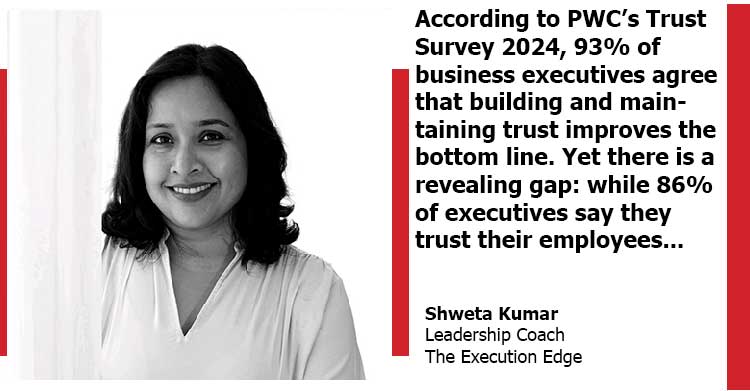Trust: The Quiet Engine Behind Execution | Shweta Kumar | Leadership Coach | The Execution Edge

Trust is often spoken of warmly in leadership conversations, but too often, it is left to chance. We call it culture, chemistry, or alignment, yet we rarely approach trust with the same rigor we apply to strategy or performance metrics. But trust is not an abstract ideal; it is the engine behind execution, the invisible scaffolding that enables teams to move from intention to impact.
The data is unambiguous. According to PWC’s Trust Survey 2024, 93% of business executives agree that building and maintaining trust improves the bottom line. Yet there is a revealing gap: while 86% of executives say they trust their employees, only 60% of employees feel highly trusted. This perception gap is not a soft issue; it speaks to the very heart of how organisations function and scale.
In my years of working with leaders across industries, I have seen how organisations that treat trust as a system, rather than a sentiment, build momentum that others struggle to match. This idea of “System Trust” is central to my book, The Execution Edge, which explores how trust, if embedded intentionally within processes, decision-making, and leadership behaviours, becomes a measurable, practical force that fuels effective execution.
What makes people trust their leaders is not performative optimism but clarity and consistency, especially in complexity. When people understand the why, the what, the who, and the how of decisions, they move from passive compliance to active ownership. They ask questions. They challenge ideas with respect. They innovate. They engage with purpose because they know their voices are heard and valued, not just tolerated.
In many organisations, the absence of trust leads to silent disengagement. People attend meetings but do not speak. Decisions are made, but commitment is thin. There is compliance, but not conviction. Strategy documents look impressive, but execution stumbles on invisible barriers of unspoken doubts and unaddressed fears. It is here that leaders need to recognise trust not as a “nice-to-have” but as the operational bedrock of execution.
Trust, is built systemically, and does not happen in a single offsite or through motivational speeches. It is nurtured in how leaders handle disagreement, how decisions are communicated, and how accountability is enforced without creating fear. It lives in the small, consistent signals that leaders send every day: inviting questions, acknowledging challenges, and demonstrating that seeking clarity is not a weakness but a strength.
In today’s environment of high stakeholder expectations, leaders are asked to deliver impressive results amidst uncertainty, while also ensuring that they create free spaces where people can express their potential. This dual challenge is best met when leaders see trust as a strategic asset. When people feel trusted, they take risks that matter, voice opinions that improve decisions, and contribute with a sense of ownership that no incentive plan alone can generate. Trust compounds over time, quietly and powerfully, allowing organisations to move
with speed and coherence.
Having a great strategy is only the starting point. The organisations that have sustained massive recessions and market shifts, and those that will sustain growth in the years ahead will be those where leaders have built the infrastructure of trust within their teams. This is what will turn your plans into progress, intentions into outcomes, and teams into communities capable of creating enduring impact.


